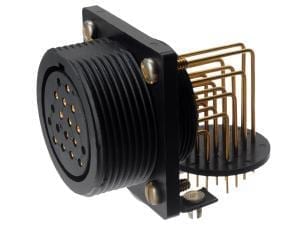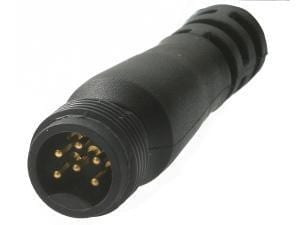PosiBlog
The Circular Argument for Durable Connectors
by Jay Sandidge, Director of Sales, Asia Pacific
Electronic connectors come in many sizes and shapes, and there are arguments and rationale for every variety. Many of the most ubiquitous high-reliability connectors are circular, or more accurately, cylindrical.
 Circular power and signal connectors can be used in many applications, ranging from aerospace equipment to medical equipment to lighting for streets and vehicles, and from industrial machines to robotics. Circular connectors are a natural fit for handling round cabling from high-speed digital, analog and power systems. They are most often used in aerospace and defense applications and medical systems. They feature multi-pin contact designs and are easily installed and removed.
Circular power and signal connectors can be used in many applications, ranging from aerospace equipment to medical equipment to lighting for streets and vehicles, and from industrial machines to robotics. Circular connectors are a natural fit for handling round cabling from high-speed digital, analog and power systems. They are most often used in aerospace and defense applications and medical systems. They feature multi-pin contact designs and are easily installed and removed.
Why are they so popular? There are at least four strong reasons.
- Circular connectors enable efficient disconnection and reconnection of a cable to its device. They were developed to replace hardwiring of cables, which could often be damaged or require extensive service. The introduction of a circular design made for a quick and compact solution.
- Their circular shape is well-suited to various locking methods, such as threaded, quarter-turn, push-pull, and bayonet-type designs. These locking styles are easy to operate with one hand, which is an important factor in many of the applications in which they are used. These locking systems can also exhibit features like auditory feedback, tactile feedback and visual feedback to the user to signal that they are, in fact, fully mated and locked.
- Circular connectors can pack many contacts into a relatively compact space. However, when higher pin counts are required, rectangular connectors may be a better option.
- Circular connectors can be built to withstand harsh conditions. They can be ruggedized and shielded against EMI/RFI, ideal for use in environments that cause signal and data interference, dirt and water contamination, extreme temperature variations, and intense shock and vibration. Because of their streamlined fit, circular connectors are well-sealed and provide consistently tough performance.
For maximum durability, these connectors are usually made of aluminum or stainless steel, or for some wash-down environments, various types of composite plastics. They usually use copper alloy-based contacts with various thickness.
History
Circular connectors were introduced in the early 1930s by Cannon (now ITT Interconnect Solutions), contracted by Douglas Aircraft Company to develop connectors for the DC-1, and subsequently the DC-2 and DC-3 aircraft platforms. During the late 1930s – with World War II looming – Cannon began volume production of multi-contact electrical connectors. Their Type “AN” (Army/Navy) series of connectors set the standard for modern military circular connector specifications, today covered under the MIL-C-5015/MIL-DTL-5015 military specification.
Circular Connectors at Positronic
Positronic has a range of circular connectors for power and signal use.
- The BKC Series is a quarter-turn, economical circular connector with high reliability power and signal solid machined contacts, and high mating cycle life and vibration-resistant capabilities.
- The Front Runner Series includes size 11 and size 19 composite circular connectors with a multiplicity of features. They meet the performance and reliability requirements of medical, transportation, and industrial applications.
- The yet to be introduced Talon family will be a line of high reliability metal circular connectors with performance profiles similar to a D38999, and options for high-speed data capability to 10 GbE.
At Positronic, our promise is that the work we do and the high-reliability products we produce will meet the highest of performance standard. We call it the Science of Certainty. Our circular connectors are a strong part of that commitment.
Latest Posts
- Milexia and Neumueller Named as Exclusive Value-Add Distributor Partners for UVAC Hermetic Feedthrough Flange System March 26, 2025
- Powering the Future of eVTOL Aircraft Travel January 24, 2025
- MACH-D Connectors: Highly Reliable & Customizable August 29, 2024
- Combo-D Connectors from Positronic: Compact Power and Precision May 1, 2024
- A Series Backshell Product Derivative: Introducing Precision Machined Banded Backshells March 12, 2024